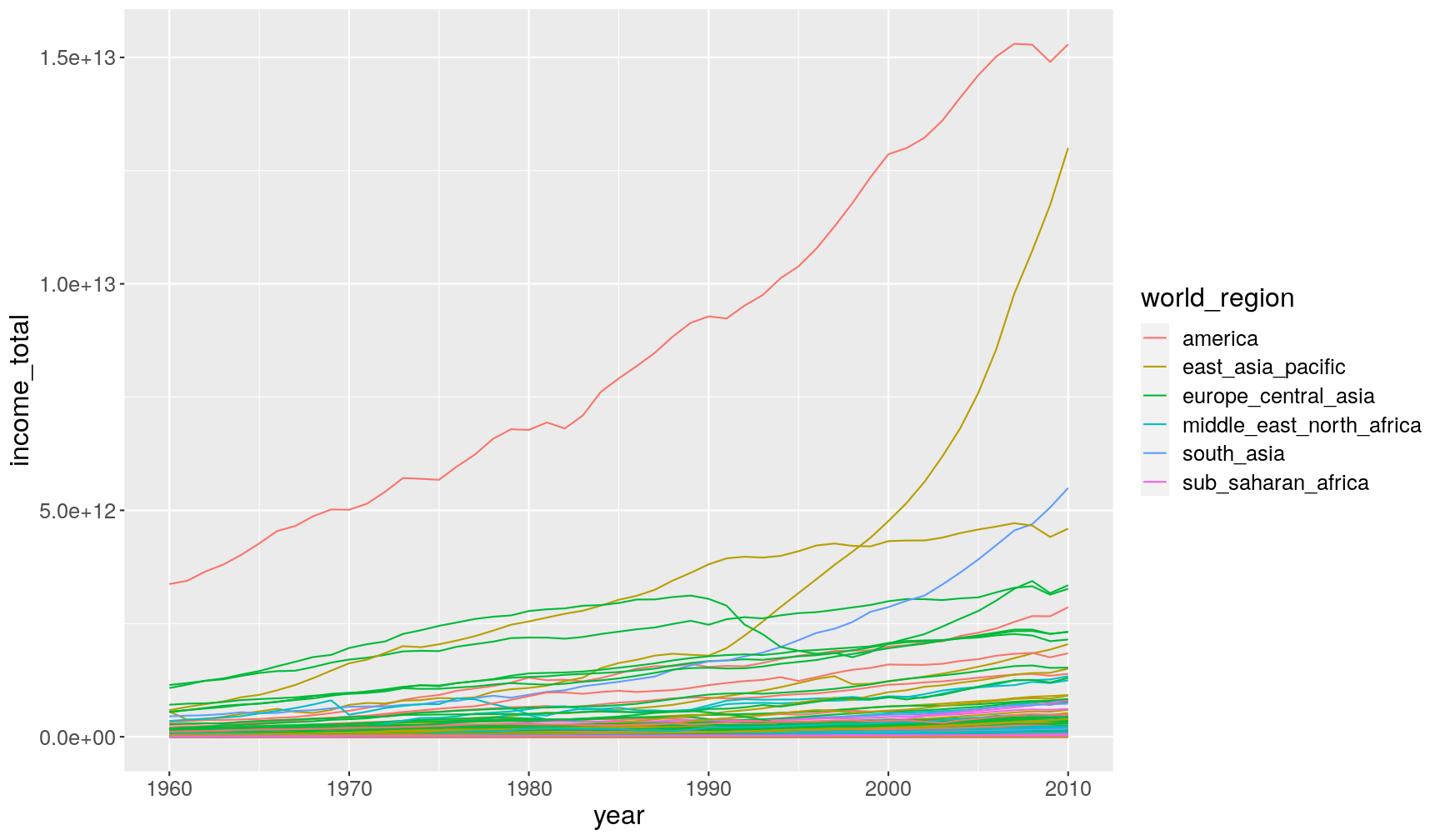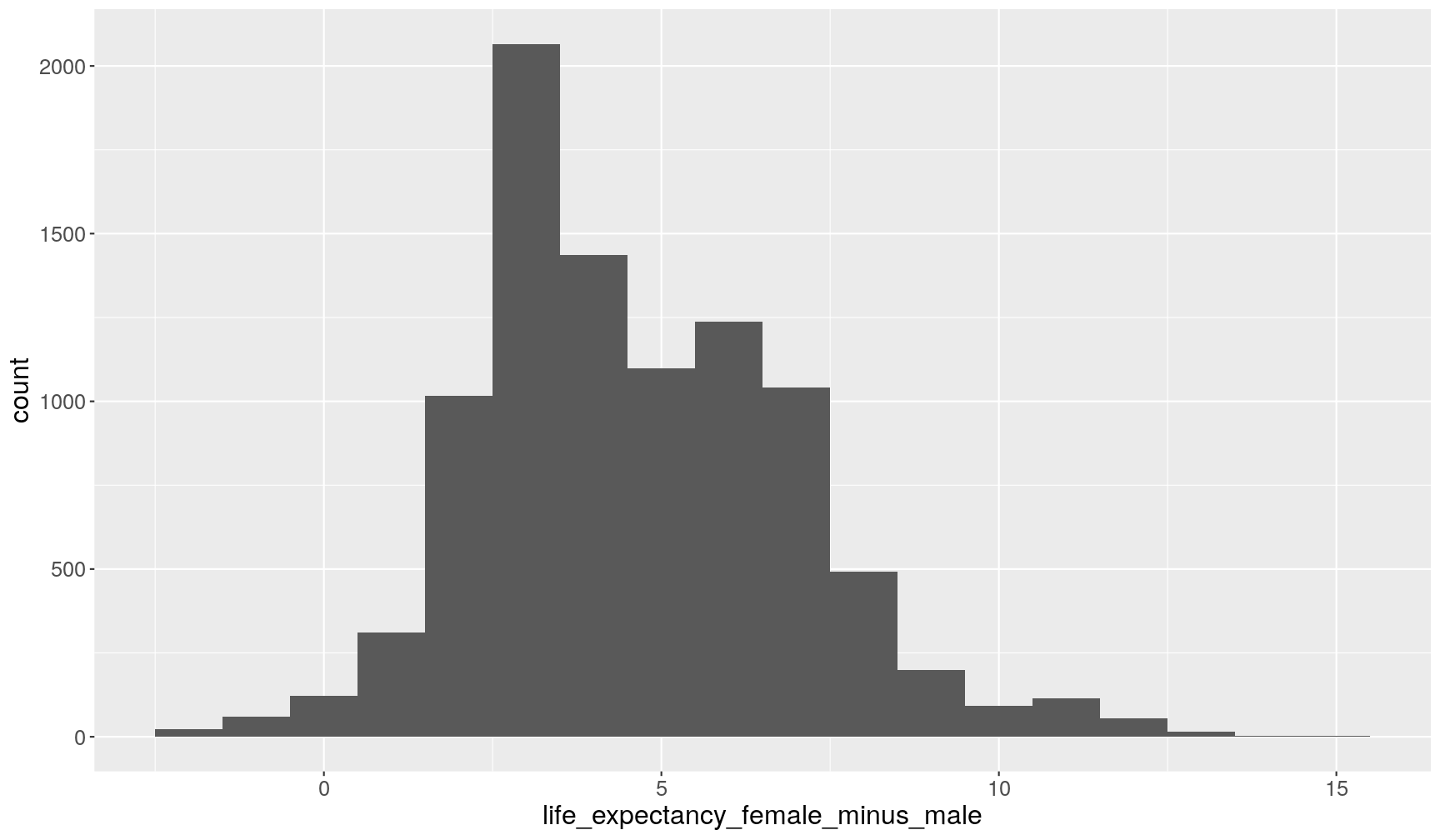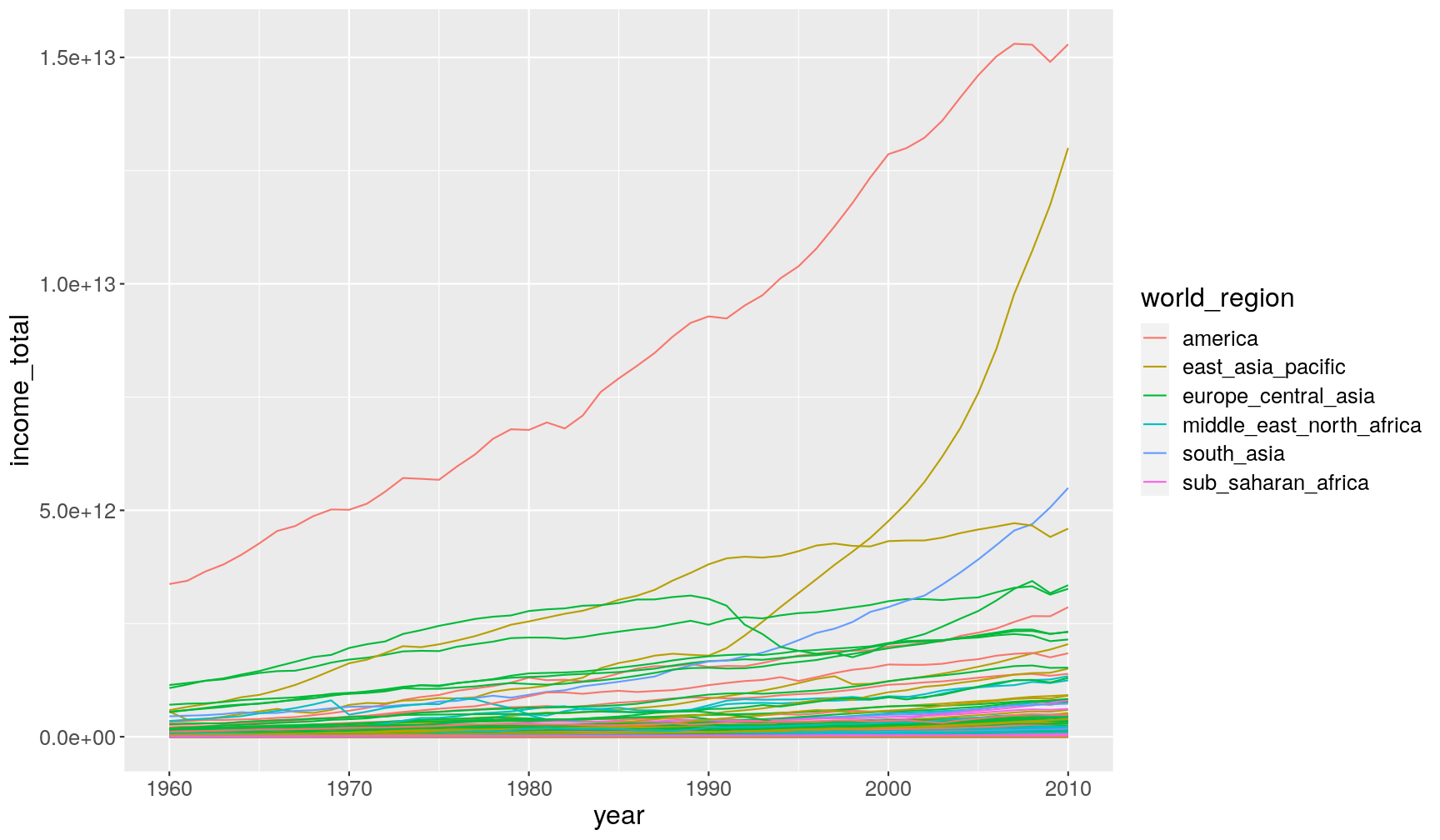Manipulating variables (columns) with `dplyr`
Overview
Teaching: 30 min
Exercises: 20 minQuestions
How to select and/or rename specific columns from a data frame?
How to create a new column or modify an existing one?
How to ‘chain’ several commands together with pipes?
Objectives
Use the
dplyrpackage to manipulate tabular data (add or modify variables, select and rename columns).Apply the functions
select(),rename()andmutate()to operate on columns.Understand and use ‘pipes’ as a way to build a chain of operations on data.
In this lesson we’re going to learn how to use the dplyr package to manipulate columns
of our data.
As usual when starting an analysis on a new script, let’s start by loading the packages and reading the data. In this lesson we’re going to start using the full dataset with data from 1960 to 2010:
library(tidyverse)
# Read the data, specifying how missing values are encoded
gapminder1960to2010 <- read_csv("data/raw/gapminder1960to2010_socioeconomic.csv",
na = "")
Selecting columns
In an earlier episode we’ve seen how to select columns (and rows) of a data frame
using the square-bracket operator [rows, columns].
With the dplyr package, there is an alternative function, which offers some flexibility
in how we choose columns.
Let’s start with a simple example of selecting two columns from our table:
select(gapminder1960to2010, country, year)
# A tibble: 9,843 x 2
country year
<chr> <dbl>
1 Afghanistan 1960
2 Afghanistan 1961
3 Afghanistan 1962
4 Afghanistan 1963
5 Afghanistan 1964
6 Afghanistan 1965
7 Afghanistan 1966
8 Afghanistan 1967
9 Afghanistan 1968
10 Afghanistan 1969
# … with 9,833 more rows
Using the base R syntax, this is equivalent to gapminder1960to2010[, c("country", "year")].
Notice that with the select() function (and generally with dplyr functions) we
didn’t need to quote " the column names. This is because the first input to the
function is the table name, and so everything after is assumed to be column names
of that table.
Where select() becomes very convenient is when combined with some other helper functions.
For example:
# Select columns which have the word "life" in their name
select(gapminder1960to2010, contains("life"))
# A tibble: 9,843 x 3
life_expectancy life_expectancy_female life_expectancy_male
<dbl> <chr> <dbl>
1 39.3 33.314 31.7
2 40.0 33.84 32.2
3 40.8 34.359 32.7
4 41.5 34.866 33.2
5 42.2 35.364 33.7
6 43.0 35.853 34.2
7 43.7 36.338 34.7
8 44.5 36.823 35.1
9 45.2 37.314 35.6
10 45.9 37.815 36.1
# … with 9,833 more rows
# Select all columns between country and year
select(gapminder1960to2010, country:year)
# A tibble: 9,843 x 3
country world_region year
<chr> <chr> <dbl>
1 Afghanistan south_asia 1960
2 Afghanistan south_asia 1961
3 Afghanistan south_asia 1962
4 Afghanistan south_asia 1963
5 Afghanistan south_asia 1964
6 Afghanistan south_asia 1965
7 Afghanistan south_asia 1966
8 Afghanistan south_asia 1967
9 Afghanistan south_asia 1968
10 Afghanistan south_asia 1969
# … with 9,833 more rows
And these can be combined with each other:
select(gapminder1960to2010, country, contains("life"), contains("_per_"))
# A tibble: 9,843 x 6
country life_expectancy life_expectancy… life_expectancy… children_per_wo…
<chr> <dbl> <chr> <dbl> <dbl>
1 Afghan… 39.3 33.314 31.7 7.45
2 Afghan… 40.0 33.84 32.2 7.45
3 Afghan… 40.8 34.359 32.7 7.45
4 Afghan… 41.5 34.866 33.2 7.45
5 Afghan… 42.2 35.364 33.7 7.45
6 Afghan… 43.0 35.853 34.2 7.45
7 Afghan… 43.7 36.338 34.7 7.45
8 Afghan… 44.5 36.823 35.1 7.45
9 Afghan… 45.2 37.314 35.6 7.45
10 Afghan… 45.9 37.815 36.1 7.45
# … with 9,833 more rows, and 1 more variable: income_per_person <dbl>
To see other helper functions to use with select() check the following help page
?select_helpers.
Finally, it can sometimes be helpful to unselect some columns. We can do this
by appending - before the column names we want to exclude, for example try running:
select(gapminder1960to2010, -country, -life_expectancy)
dplyrsyntaxAll
dplyrfunctions follow the following convention:
- The first input to the function is always a
data.frame/tibble.- Next come other inputs specific to the function. Column names usually don’t need to be quoted
".- The output is always a
data.frame/tibble.
Renaming columns
Use the rename() function to change column names, with the following syntax:
rename(my_table, new_column_name = old_column_name). For example:
rename(gapminder1960to2010,
continent = world_region, gdp_per_capita = income_per_person)
# A tibble: 9,843 x 13
country continent year children_per_wo… life_expectancy gdp_per_capita
<chr> <chr> <dbl> <dbl> <dbl> <dbl>
1 Afghan… south_as… 1960 7.45 39.3 2744
2 Afghan… south_as… 1961 7.45 40.0 2702
3 Afghan… south_as… 1962 7.45 40.8 2683
4 Afghan… south_as… 1963 7.45 41.5 2665
5 Afghan… south_as… 1964 7.45 42.2 2649
6 Afghan… south_as… 1965 7.45 43.0 2641
7 Afghan… south_as… 1966 7.45 43.7 2598
8 Afghan… south_as… 1967 7.45 44.5 2601
9 Afghan… south_as… 1968 7.45 45.2 2623
10 Afghan… south_as… 1969 7.45 45.9 2594
# … with 9,833 more rows, and 7 more variables: is_oecd <lgl>,
# income_groups <chr>, population <dbl>, main_religion <chr>,
# child_mortality <dbl>, life_expectancy_female <chr>,
# life_expectancy_male <dbl>
Creating or modifying columns
To create new columns or modify existing ones, we can use the mutate() function.
Here is an example where we calculate the population in millions for each country:
mutate(gapminder1960to2010,
population_millions = population/1e6)
# A tibble: 9,843 x 14
country world_region year children_per_wo… life_expectancy income_per_pers…
<chr> <chr> <dbl> <dbl> <dbl> <dbl>
1 Afghan… south_asia 1960 7.45 39.3 2744
2 Afghan… south_asia 1961 7.45 40.0 2702
3 Afghan… south_asia 1962 7.45 40.8 2683
4 Afghan… south_asia 1963 7.45 41.5 2665
5 Afghan… south_asia 1964 7.45 42.2 2649
6 Afghan… south_asia 1965 7.45 43.0 2641
7 Afghan… south_asia 1966 7.45 43.7 2598
8 Afghan… south_asia 1967 7.45 44.5 2601
9 Afghan… south_asia 1968 7.45 45.2 2623
10 Afghan… south_asia 1969 7.45 45.9 2594
# … with 9,833 more rows, and 8 more variables: is_oecd <lgl>,
# income_groups <chr>, population <dbl>, main_religion <chr>,
# child_mortality <dbl>, life_expectancy_female <chr>,
# life_expectancy_male <dbl>, population_millions <dbl>
The new column is attached to the end of the table. We can’t see its values printed here, because there are too many columns, but we can see that it is listed at the bottom of the printed result.
Notice that the gapminder1960to2010 object did not change, because we didn’t assign
(<-) the output of mutate() to it. To update our table, then we need to do:
gapminder1960to2010 <- mutate(gapminder1960to2010,
population_millions = population/1e6)
Now, we can check its values by using select(), as we’ve learned above:
select(gapminder1960to2010,
country, population, population_millions)
# A tibble: 9,843 x 3
country population population_millions
<chr> <dbl> <dbl>
1 Afghanistan 8996967 9.00
2 Afghanistan 9169406 9.17
3 Afghanistan 9351442 9.35
4 Afghanistan 9543200 9.54
5 Afghanistan 9744772 9.74
6 Afghanistan 9956318 9.96
7 Afghanistan 10174840 10.2
8 Afghanistan 10399936 10.4
9 Afghanistan 10637064 10.6
10 Afghanistan 10893772 10.9
# … with 9,833 more rows
Chaining commands with the %>% pipe
In the examples above, we saw how to perform each of these operations individually. But what if we wanted to mutate, then select some columns and then rename some of those?
This type of operation, where we want to chain several commands after each other,
can be done with pipes. In tidyverse pipes look like %>%.
Let’s see an example in action:
gapminder1960to2010 %>%
mutate(population = population/1e6) %>%
select(country, world_region, population) %>%
rename(continent = world_region)
# A tibble: 9,843 x 3
country continent population
<chr> <chr> <dbl>
1 Afghanistan south_asia 9.00
2 Afghanistan south_asia 9.17
3 Afghanistan south_asia 9.35
4 Afghanistan south_asia 9.54
5 Afghanistan south_asia 9.74
6 Afghanistan south_asia 9.96
7 Afghanistan south_asia 10.2
8 Afghanistan south_asia 10.4
9 Afghanistan south_asia 10.6
10 Afghanistan south_asia 10.9
# … with 9,833 more rows
Let’s break this down:
- We start with the data,
gapminder1960to2010and “pipe” it (%>%) to the next function,mutate(). - In
mutate()we didn’t need to specific a table, because it’s been given to it through the pipe. So, we went straight away to modify our population column. And we again “piped” its output to the next function,select(). select()then receives this table, which has the modifiedpopulationcolumn, and so we only need to specify which columns we want to select. And again, we send this to…rename(), which again receives it’s input from the pipe. And our chain of commands ends here.
You can interpret the %>% as meaning “and then”, and so we can read the code above as:
Take the
gapminder1960to2010table and then add a modify the population column and then select only some of the columns and then rename one of the columns.
Using the Dot
.With%>%PipesIn the example above we didn’t need to specify the input to each function chained through the pipes. This is because what
%>%does is pass the output of the function on its left as the first argument to the function on its right. However, you can also explicitly define where the input from the pipe goes to. You achieve this by using the.symbol, for example these two are equivalent:gapminder1960to2010 %>% select(country, world_region) gapminder1960to2010 %>% select(., country, world_region)The
.can usually be ommited, as the output of the pipe will automatically be passed on as the first input to the next function.However, in some cases the use of
.is needed, if the function that comes after the pipe doesn’t take the data frame as it’s first argument. For example, thelm()function, used to fit linear models (e.g. linear regression) first needs a definition of the model being fitted (theformulaargument) and only after the data frame (thedataargument). Check?lmdocumentation to see that this is the case.So, if we want to fit a linear regression between life expectancy and income, using a pipe, this is what we would have to do:
gapminder1960to2010 %>% lm(formula = life_expectancy ~ income_per_person, data = .)Covering linear models is beyond the scope of this lesson, but the main point is that for this function, because
datais not the first input to the function, we need to use the.explicitly.
The purpose of the pipes is to make the order of the data manipulation steps clear, and we will be using them throughout the course. However, they are not mandatory, and the same operations could have been done without them. For example, by saving the output of each step in a temporary object, which would then be used as input to the next function. Here are the same steps as above using this strategy:
# First mutate the column of interest
gapminder1960to2010_modified <- mutate(gapminder1960to2010,
population = population/1e6)
# Then select columns of interest from this modified table
gapminder1960to2010_modified <- select(gapminder1960to2010_modified,
country, world_region, population)
# Finally rename the modified table
rename(gapminder1960to2010_modified, continent = world_region)
One clear disadvantage of this approach is that we now have an object gapminder1960to2010_modified
loaded in our Environment (top-right panel of RStudio), which we may actually only
be interested in temporarily.
Exercise
Use the
mutate()function to help you solve this questions.
- When we previously explored our data, we realised that
life_expectancy_femalewas imported as character rather than numeric. Updategapminder1960to2010by coercing (i.e. converting) this variable to numeric type (hint: useas.numeric()within themutate()function).- Make a histogram of the difference between the life expectancy of the two sexes (hint: pipe these operations
data.frame %>% mutate %>% ggplot) (hint2: use a binwidth of 1 year for the histogram withgeom_histogram(binwidth = 1))- Fix the following code recreate the plot below showing how the total income of a country changed over time. (hint: calculate the total income from
populationandincome_per_person)# take the data; and then... gapminder1960to2010 %>% # ... calculate total income; and then... mutate(income_total = FIXME) %>% # ... make the plot ggplot(aes(x = FIXME, y = FIXME)) + geom_line(aes(group = country, colour = world_region))
(While doing the exercise, always try to critically evaluate your results!)
Answer
A1. Because we want to modify a column, we use the
mutate()function. We will also use theas.numeric()function to convert the values oflife_expectancy_femaleto numeric:gapminder1960to2010 <- gapminder1960to2010 %>% mutate(life_expectancy_female = as.numeric(life_expectancy_female))We get a warning from the function indicating that values that could not be converted to a number were encoded as missing. This is OK in our case, since what happened in this column is that the missing values had been encoded as “-“.
A2. To create this plot, we can use pipes, to first create a new column using
mutate()and then passing the output of that step toggplot:# take the data; and then... gapminder1960to2010 %>% # ... calculate life expectancy difference; and then... mutate(life_expectancy_female_minus_male = life_expectancy_female - life_expectancy_male) %>% # ... make the plot ggplot(aes(life_expectancy_female_minus_male)) + geom_histogram(binwidth = 1)Warning: Removed 459 rows containing non-finite values (stat_bin).
This shows that overall women live longer than men. This trend seems to hold across all countries and across many years. Although from just the histogram it’s not clear how this changed over time.
A3. We can do all these operations with a pipe:
# take the data; and then... gapminder1960to2010 %>% # ... calculate total income; and then... mutate(income_total = income_per_person*population) %>% # ... make the plot ggplot(aes(year, income_total)) + geom_line(aes(group = country, colour = world_region))Warning: Removed 459 row(s) containing missing values (geom_path).
Note how we’ve used
group = countryinsidegeom_line(), to indicate that each country should have its own line (otherwise ggplot would have connected all data points belonging to the same world_region together, resulting in a big mess! Try removing this option to see what happens.It feels like in most countries there is an increase in total income. However, it’s hard to see with this scale, given that there’s two countries which really are outliers from the rest. Given the world region they’re from, they’re likely to be China and United States, although this would require further investigation.
Key Points
Use
dplyr::select()to select columns from a table.Select a range of columns using
:, columns matching a string withcontains(), and unselect columns by using-.Rename columns using
dplyr::rename().Modify or update columns using
dplyr::mutate().Chain several commands together with
%>%pipes.


